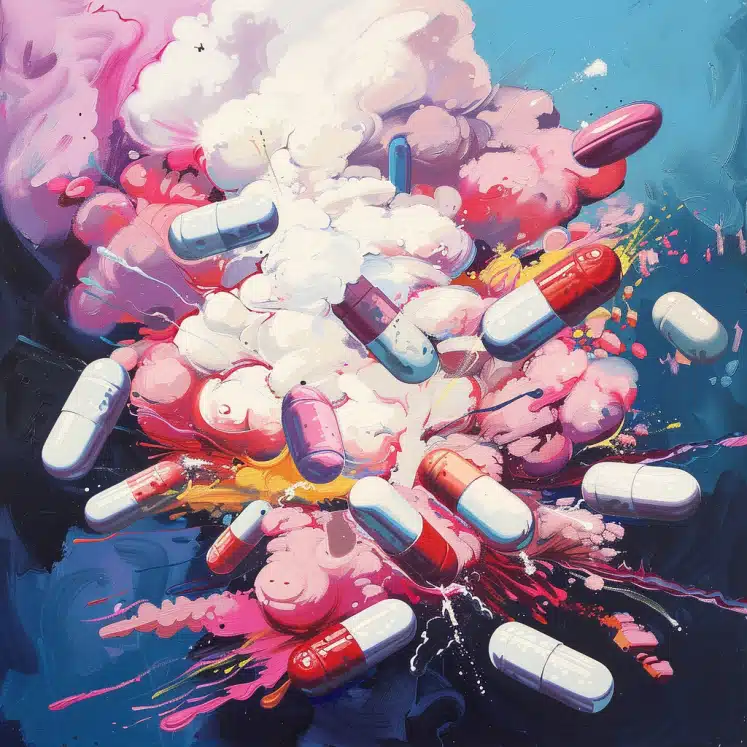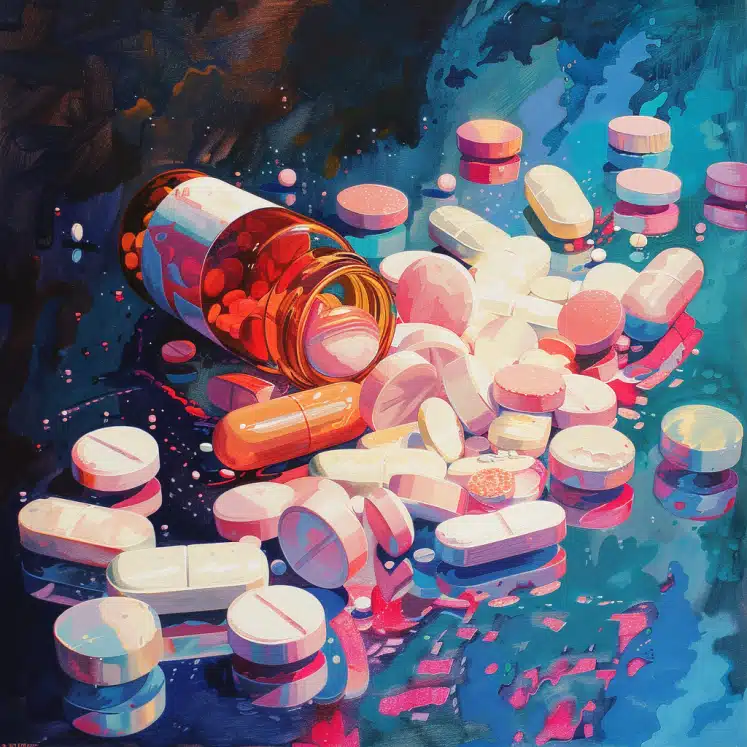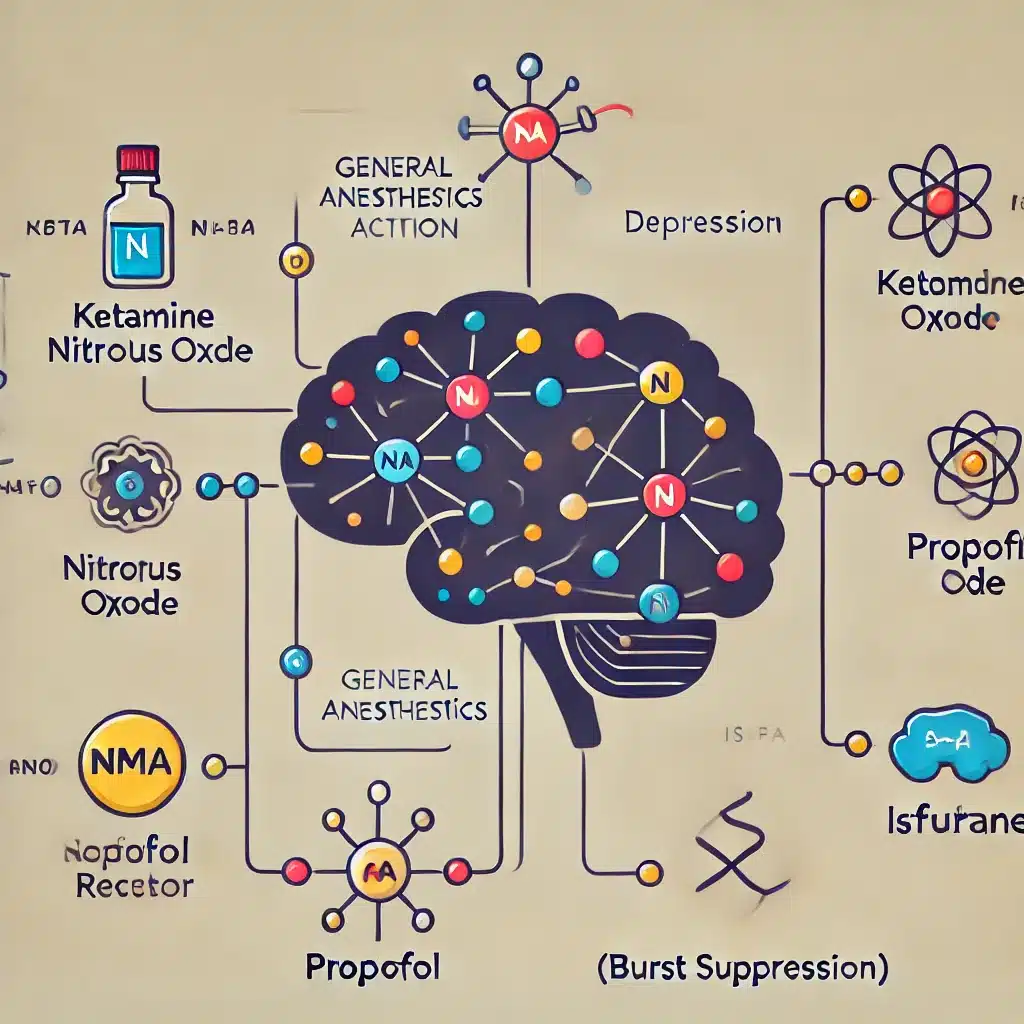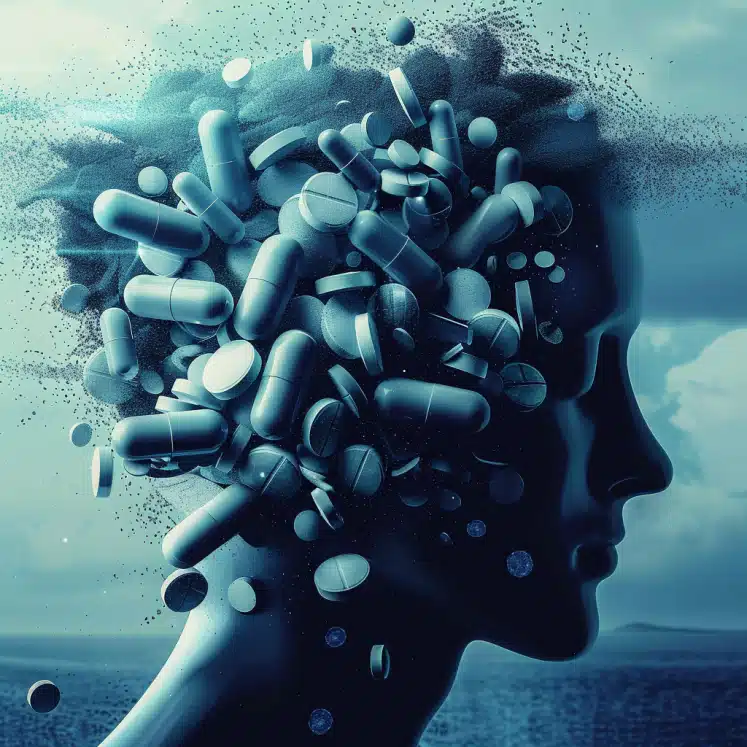Source: Anesthesiology (2024)
Main Points: Repurposed General Anesthetic Drugs for Depression (2024)
1. Revolutionizing Depression Treatment with Anesthetic Drugs
The introduction of general anesthetic drugs in the mid-nineteenth century revolutionized surgical practice by enabling pain-free, complex, and prolonged surgeries.
Now, these anesthetics are addressing a new critical need: the treatment of depression.
Ketamine, nitrous oxide, propofol, and isoflurane have shown promising rapid and sustained antidepressant effects, offering hope for new treatments for major depressive disorder (MDD), treatment-resistant depression, and bipolar depression.
2. Challenge of Treating Major Depression
Major depressive disorder (MDD) affects over 300 million people globally, with an estimated lifetime prevalence of 11%.
It is the leading cause of global disability, associated with significant healthcare costs and reduced quality of life.
Traditional antidepressants, which target the monoamine system, often take weeks or months to become effective and have side effects that limit adherence.
Moreover, about one-third of MDD patients do not respond to conventional treatments, developing treatment-resistant depression.
3. Ketamine: A Breakthrough Antidepressant
Ketamine has demonstrated rapid antidepressant effects, showing significant symptom improvement within hours.
A landmark study in 2000 by Berman et al. revealed that a single intravenous dose of ketamine significantly improved depressive symptoms within 72 hours.
Subsequent studies have confirmed these findings, positioning ketamine as a groundbreaking treatment for MDD and treatment-resistant depression.
Ketamine works by modulating glutamatergic neurotransmission, promoting synaptic plasticity and restoring synaptic efficacy.
4. Other Promising Anesthetic Drugs
- Nitrous Oxide: Clinical trials have shown that nitrous oxide can reduce depression symptoms and suicidal ideation, with its effects likely mediated through NMDA receptor modulation and enhanced synaptic responses.
- Propofol: Preliminary studies suggest propofol’s antidepressant effects are linked to its modulation of GABAergic neurotransmission and dopamine transporters, enhancing synaptic plasticity and mood improvement.
- Isoflurane: Although initial studies showed rapid antidepressant effects similar to electroconvulsive therapy, subsequent research yielded mixed results. Isoflurane’s antidepressant mechanisms may involve cortical burst suppression and neuroplasticity.
5. Mechanisms of Action
Anesthetic drugs with antidepressant properties primarily modulate excitatory glutamatergic and inhibitory GABAergic neurotransmission.
Ketamine and nitrous oxide act as noncompetitive NMDA receptor inhibitors, enhancing synaptic plasticity and promoting neurogenesis.
Propofol’s effects involve increased expression of α5GABAA receptors and modulation of dopamine transporters.
6. Interdisciplinary Collaboration
The integration of anesthesiology and psychiatry is vital for advancing the use of anesthetic drugs in depression treatment.
Collaboration can optimize treatment protocols, deepen understanding of antidepressant mechanisms, and improve patient outcomes.
Joint research training, interdisciplinary clinical trials, collaborative grant writing, and integrated educational programs are key strategies to foster collaboration.
7. Advancing Research of Anesthetics
Future research aims to optimize dosing regimens, identify suitable patient populations, and mitigate side effects.
New formulations, such as esketamine nasal spray, highlight innovative delivery methods.
Further studies are needed to understand the precise mechanisms of action, the role of neuroactive metabolites, and the long-term efficacy and safety of these treatments.
Promising General Anesthetic Drugs Repurposed for Depression

1. Ketamine
Mechanisms of Action:
- NMDA Receptor Antagonism: Ketamine is a noncompetitive antagonist of NMDA receptors, primarily on GABAergic interneurons. This inhibition reduces GABA release, leading to disinhibition of pyramidal neurons, enhancing excitatory neurotransmission.
- Synaptic Plasticity: By increasing BDNF levels and activating the mTOR pathway, ketamine promotes synaptic growth and plasticity, which are critical for its antidepressant effects.
- Restoration of Glutamate Homeostasis: Ketamine helps restore the balance of glutamate in the brain, improving synaptic function and connectivity.
Onset of Effect: Ketamine can produce rapid antidepressant effects within hours, typically noticeable within 2 hours of administration.
Duration of Efficacy: The antidepressant effects can last for several days to weeks, with peak effects usually observed within 24-72 hours post-administration.
2. Nitrous Oxide
Mechanisms of Action:
- NMDA Receptor Inhibition: Similar to ketamine, nitrous oxide inhibits NMDA receptor-mediated currents, reducing excitatory neurotransmission and potentially enhancing synaptic plasticity.
- Synaptic Responses: Nitrous oxide exposure can lead to enhanced synaptic responses and upregulation of neuroplasticity-related factors like BDNF.
Onset of Effect: The antidepressant effects of nitrous oxide can be observed within hours, often noticeable within the first 24 hours after administration.
Duration of Efficacy: Effects typically last for at least 24 hours and can extend up to a week, with ongoing studies investigating the optimal dosing and duration.
3. Propofol
Mechanisms of Action:
- GABAA Receptor Modulation: Propofol acts as a positive allosteric modulator of GABAA receptors, enhancing inhibitory neurotransmission. It particularly increases the expression of α5GABAA receptors, which are crucial for mood regulation.
- Dopamine Transporter Inhibition: Propofol may also inhibit dopamine transporters, increasing dopamine levels in key brain areas involved in reward and mood.
Onset of Effect: The antidepressant effects of propofol can be observed within hours to days following administration.
Duration of Efficacy: Initial studies suggest the effects can last from several days to weeks, but more research is needed to determine the optimal dosing and duration.
4. Isoflurane
Mechanisms of Action:
- Cortical Burst Suppression: Isoflurane induces burst suppression on the EEG, which is associated with rapid antidepressant effects similar to those observed with electroconvulsive therapy.
- Neuroplasticity: Isoflurane may normalize levels of neuroplasticity markers like BDNF and promote dendritic spine formation.
Onset of Effect: Antidepressant effects can be seen immediately to a few days after administration.
Duration of Efficacy: The effects can last for several days to weeks, but results have been mixed and further research is required.
Investigational Anesthetics for Depression Treatment

Esketamine
Mechanisms of Action:
- NMDA Receptor Antagonism: Esketamine, the S-enantiomer of ketamine, shares similar mechanisms with ketamine, including NMDA receptor antagonism and enhancement of synaptic plasticity.
Onset of Effect: Esketamine can produce rapid effects within hours, similar to ketamine.
Duration of Efficacy: Effects can last for several days to weeks, with nasal spray formulations approved for treatment-resistant depression.
Sevoflurane
Mechanisms of Action:
- TrkB Activation: Sevoflurane has been shown to increase expression levels of TrkB in the hippocampus and prefrontal cortex, promoting neuroplasticity.
Onset of Effect: Preliminary studies indicate antidepressant effects may be observed within days.
Duration of Efficacy: The duration of effects is still under investigation, with ongoing studies exploring its potential as a depression treatment.
Mechanisms of General Anesthetic Drugs in Depression

1. Glutamatergic Neurotransmission
Ketamine: Ketamine’s antidepressant effects are primarily attributed to its modulation of glutamatergic neurotransmission.
It acts as a noncompetitive inhibitor of NMDA (N-methyl-D-aspartate) receptors, which are critical for excitatory neurotransmission in the brain.
Ketamine inhibits NMDA receptors on GABAergic interneurons, leading to reduced GABA release. This disinhibition increases the excitability of pyramidal neurons, enhancing synaptic plasticity. Key downstream effects include:
- Increased Brain-Derived Neurotrophic Factor (BDNF) Levels: Ketamine promotes the release of BDNF, which supports the growth and differentiation of new neurons and synapses.
- Activation of mTOR Pathway: The mammalian target of rapamycin (mTOR) pathway is activated, leading to increased protein synthesis and the growth of dendritic spines, essential for synaptic plasticity and resilience.
- Synaptic Homeostasis: Ketamine restores glutamate homeostasis, improving synaptic efficacy and density, crucial for mood regulation.
Nitrous Oxide: Nitrous oxide also targets NMDA receptors but exhibits a different mechanism:
- NMDA Receptor Inhibition: It inhibits NMDA receptor-mediated currents, reducing excitatory neurotransmission and potentially increasing synaptic plasticity.
- Enhanced Synaptic Responses: Brief exposure to nitrous oxide can enhance synaptic responses in hippocampal neurons, suggesting a lasting impact on synaptic strength and plasticity.
- Upregulation of Neuroplasticity Factors: Nitrous oxide may increase the expression of neuronal nitric oxide synthase (nNOS) and BDNF, promoting synaptic growth and plasticity.
2. GABAergic Neurotransmission
Propofol: Propofol is a positive allosteric modulator of GABAA receptors, enhancing inhibitory neurotransmission. Key mechanisms include:
- Enhanced GABAA Receptor Function: Propofol increases the cell-surface expression of α5GABAA receptors, which are highly expressed in the hippocampus and prefrontal cortex—areas critical for mood regulation.
- Astrocyte-to-Neuron Crosstalk: Propofol triggers astrocytes to release paracrine factors that upregulate α5GABAA receptor expression in neurons, enhancing inhibitory control.
- Modulation of Dopamine Transporters: Propofol may inhibit dopamine transporters, increasing dopamine levels in the nucleus accumbens, a key area for reward and motivation, thus alleviating anhedonia.
3. Cortical Burst Suppression & Neuroplasticity
Isoflurane: Isoflurane’s antidepressant properties may involve cortical burst suppression, similar to electroconvulsive therapy:
- EEG Burst Suppression: Isoflurane induces burst suppression on the EEG, which correlates with rapid antidepressant effects.
- Normalization of Neuroplasticity Markers: In animal models, isoflurane normalizes BDNF protein expression, activates TrkB receptors, and promotes dendritic spine formation, essential for neuroplasticity and mood regulation.
4. Additional Mechanisms
Modulation of Synaptic Connectivity: General anesthetics like ketamine and nitrous oxide enhance synaptic connectivity and communication between brain regions involved in mood regulation, such as the prefrontal cortex and hippocampus.
Reduction of Inflammatory Markers: Ketamine has been shown to reduce pro-inflammatory cytokines, which are often elevated in patients with depression. This anti-inflammatory effect may contribute to its rapid antidepressant action.
Regulation of Neurotransmitter Systems: While primarily targeting glutamate and GABA systems, general anesthetics also influence other neurotransmitter systems, including serotonin, dopamine, and opioid receptors, contributing to their complex antidepressant effects.
Conclusion: Repurposed General Anesthetics for Depression
The repurposing of general anesthetic drugs such as ketamine, nitrous oxide, propofol, and isoflurane marks a significant advancement in the treatment of depression, particularly for those suffering from major depressive disorder and treatment-resistant depression.
These drugs offer rapid and sustained antidepressant effects by targeting key neurotransmitter systems and promoting synaptic plasticity.
The swift onset of action, often within hours, provides a critical advantage over traditional antidepressants, which typically require weeks to become effective.
Collaborative efforts between anesthesiology and psychiatry are essential to further understand these mechanisms and optimize treatment protocols.
Future research will focus on refining dosing regimens, mitigating side effects, and exploring the long-term efficacy of these anesthetics.
By leveraging these innovative approaches, we can offer new hope to patients with debilitating mood disorders and improve overall mental health outcomes.
References
- Study: Repurposing General Anesthetic Drugs to Treat Depression: A New Frontier for Anesthesiologists in Neuropsychiatric Care (2024)
- Authors: Connor T A Brenna et al.







